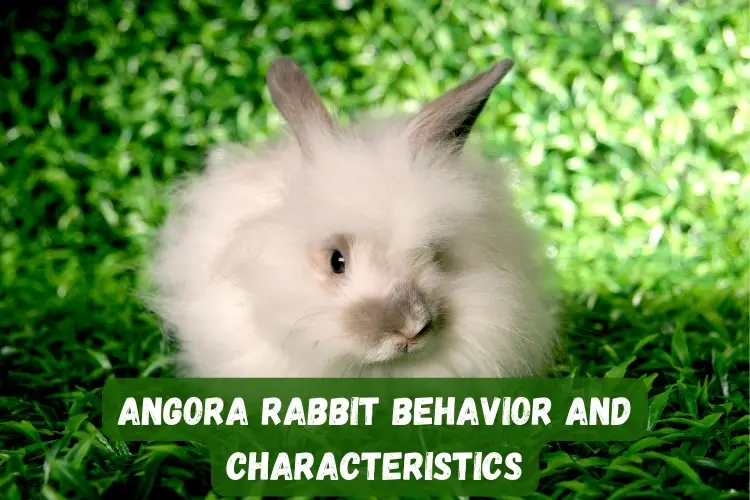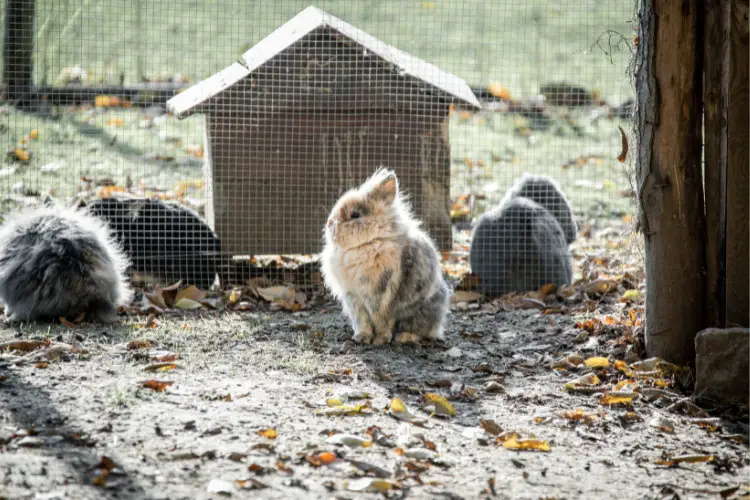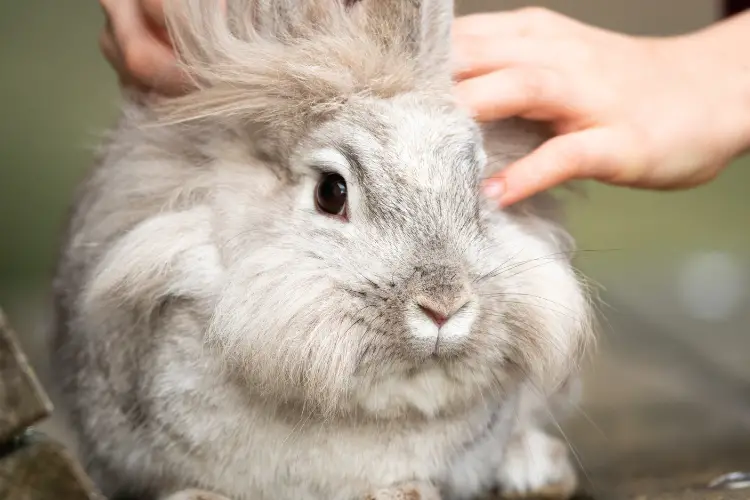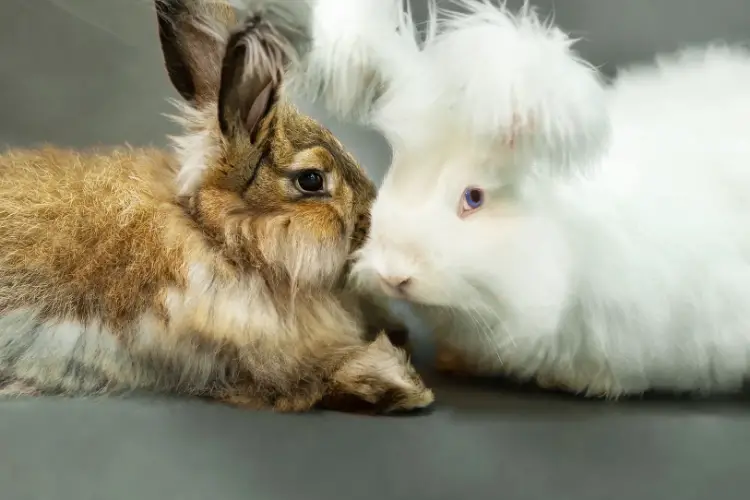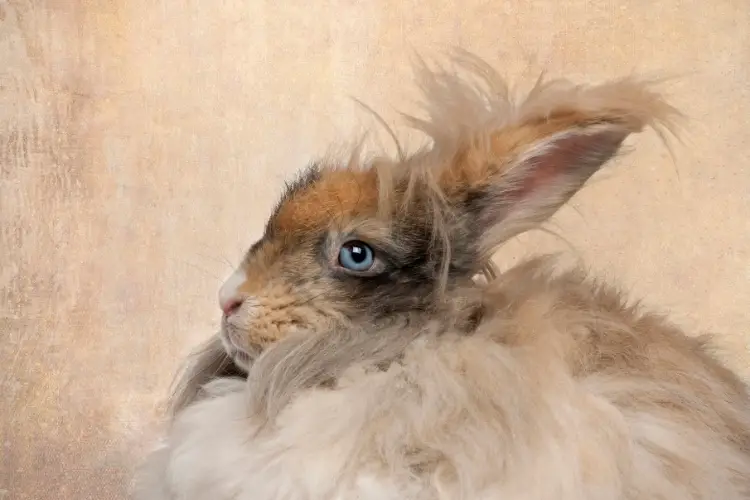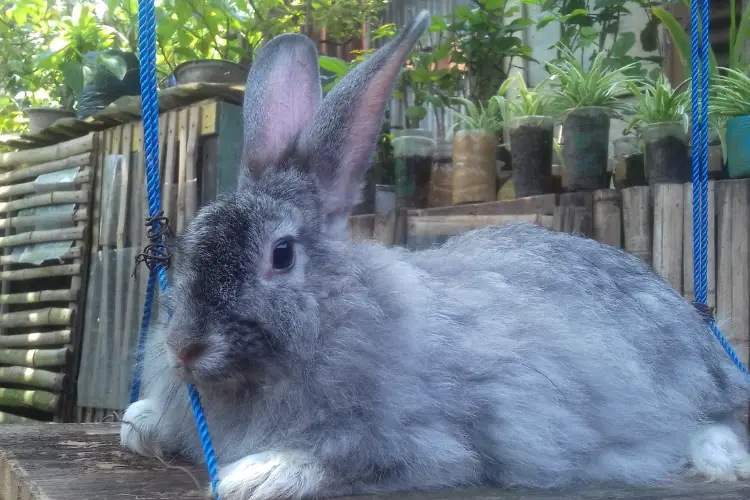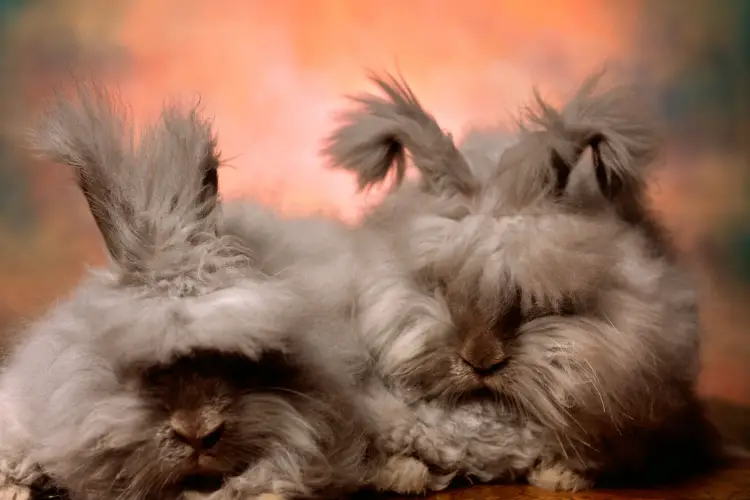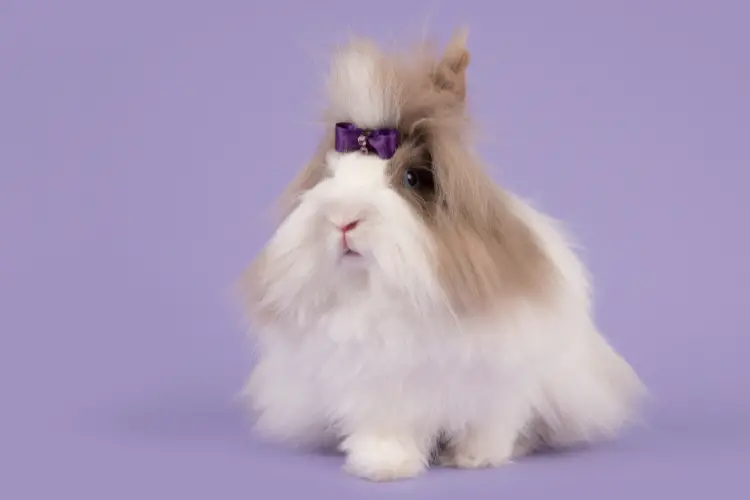Angora rabbits are beloved for their soft, luxurious wool and charming personalities. While they may appear to be simply cute and fluffy, understanding the behavior and characteristics of Angora rabbits is essential for their proper care and well-being.
In this blog post guide, we will be looking into the social dynamics, physical traits, and health considerations of these unique animals, with a special focus on the senior Angora pair, Brie and Camembert, who have their own distinct quirks and needs.
Key Takeaways
- Angora rabbits require regular grooming due to their long coat, with senior rabbits like Brie and Camembert needing extra care to manage their fur.
- Senior Angora rabbits can have specific health needs, such as joint stiffness and mobility issues, and may benefit from daily pain medication to improve energy levels.
- Despite common misconceptions, Angora rabbits can have well-tempered personalities and may not always exhibit destructive behaviors like chewing cords or digging carpets.
- Adopting senior rabbits involves considerations such as their compatibility with children and other animals, as well as the creation of a rabbit-friendly home environment.
- Each Angora rabbit has a unique personality, as seen with Brie’s affectionate nature and Camembert’s more independent demeanor, which can include a sassy side.
Understanding Angora Rabbit Behavior
Social Dynamics and Bonding
Angora rabbits are social creatures that thrive on companionship, both with their human caretakers and fellow rabbits. Bonding between rabbits is a delicate process that requires patience and understanding of their social cues.
A bonded pair, like Brie and Camembert, often form a deep connection, providing each other with comfort and security. When introducing rabbits for potential bonding, it’s important to monitor their interactions closely.
Positive signs include grooming each other and lying down together, while aggressive behavior such as chasing or nipping may indicate that the pairing is not a good match. It’s essential to provide a neutral space for these introductions to prevent territorial disputes.
For those considering adopting an Angora rabbit, it’s crucial to recognize their need for a quiet environment and gentle handling. This is especially important in households with young children, as the energy and excitement of toddlers can be overwhelming for these sensitive animals. Here are some tips for creating a suitable environment for an Angora rabbit:
- Ensure a calm and stable setting.
- Provide plenty of space for exercise and exploration.
- Offer hideouts and toys for mental stimulation.
- Maintain a consistent routine for feeding and interaction.
Common Behavioral Traits
Angora rabbits are known for their intelligence and affectionate nature, often forming strong bonds with their caregivers. They exhibit a range of behaviors that reflect their social and curious disposition. For instance, they may seek out interaction through gentle nudging or by offering their head for strokes.
However, they also have their unique quirks, such as a propensity for chewing and digging, which can be managed with appropriate environmental enrichment.
When it comes to their daily activities, Angora rabbits display a pattern of alternating between active and restful periods. They are most lively during dawn and dusk, which are their natural feeding times in the wild. During these times, they may engage in ‘binkying’—a joyful expression where they jump and twist in the air.
It’s important for owners to recognize and accommodate these natural behaviors to ensure their rabbit’s well-being.
Here is a list of common behavioral traits observed in Angora rabbits:
- Affectionate interactions with humans
- Curiosity and exploration of their environment
- Active during dawn and dusk (crepuscular)
- Chewing and digging habits
- ‘Binkying’ as a sign of happiness and playfulness
Interactions with Humans and Other Animals
Angora rabbits are known for their gentle and affectionate nature, making them excellent companions for humans. They thrive on social interaction and often seek out the company of their owners.
Regular handling and petting can help to strengthen the bond between rabbit and owner, as Angoras enjoy being petted and stroked due to their soft, velvety fur.
When it comes to interactions with other animals, Angora rabbits can be socialized to get along with certain pets, such as well-behaved dogs and cats. However, it’s crucial to introduce them carefully and supervise interactions to ensure safety for all animals involved. Here’s a simple guide to help you introduce your Angora rabbit to other pets:
- Start by keeping the animals in separate but adjacent spaces where they can see and smell each other.
- Gradually allow supervised, short interactions in a neutral area.
- Observe their body language closely for signs of stress or aggression.
- Continue with regular, supervised meetings until you are confident they are comfortable with each other.
Physical Characteristics of Angora Rabbits
Coat Types and Grooming Needs
Angora rabbits are renowned for their luxurious coats, which require regular maintenance to prevent matting and ensure their well-being.
Daily brushing is essential, particularly for mixed breeds like Cam, who may struggle to groom themselves due to stiffness in their joints. A monthly full grooming session is also recommended to keep their coat in top condition.
While some Angoras, such as Brie, are better at self-maintenance, they still benefit from gentle brushing to remove loose fur. It’s important to be mindful of sensitive areas and to provide care with a soft touch, especially around the hindquarters.
Despite the occasional protest, such as a ‘thump’ to express displeasure, Angoras typically tolerate grooming well, making it a bonding experience for both the rabbit and the owner.
Here are some grooming tools and their purposes:
- Slicker brush: Removes loose fur and prevents matting.
- Dematting comb: Helps to gently cut through and remove mats.
- Bristle brush: For finishing touches, giving the coat a smooth shine.
Regular grooming not only keeps the Angora’s coat beautiful but also serves as an opportunity to check for any skin issues or parasites. It’s a crucial aspect of their care that potential adopters should be prepared to undertake.
Color Variations
Angora rabbits are celebrated for their diverse and vibrant coat colors, which can significantly vary from one individual to another. Rabbits can range in color from red to carrot-like orange to cream, adding to their appeal among enthusiasts and pet owners alike.
The palette of colors in Angora rabbits is not only a matter of aesthetics but also genetics, with certain colors being more prevalent in specific lineages.
When considering the color variations of Angora rabbits, it’s important to recognize the common hues that are found within the breed. Below is a list of some of the most popular colors observed in these fluffy companions:
- White, often associated with purity and a classic look
- Grey, providing a dignified and elegant appearance
- Black, known for its striking contrast against the Angora’s wool
- Brown, ranging from light to dark shades, offering a natural and earthy feel
- Fawn, a warm and inviting color that is both soft and subtle
Each color carries its own unique charm and may influence an individual’s decision when selecting their furry friend. It’s essential for potential owners to understand that regardless of the color, the care and maintenance of an Angora rabbit’s coat remain a significant commitment.
Size and Physical Health Considerations
Angora rabbits, known for their luxurious fur, also require special attention when it comes to their physical health. Senior Angora rabbits may face challenges such as arthritis, which can impact their mobility and overall quality of life.
It’s crucial to monitor their weight and body condition, as obesity can exacerbate these issues. Regular veterinary check-ups are essential for maintaining the health of senior Angora rabbits. These appointments can help identify and manage common age-related conditions.
For instance, Satin Angora Rabbits are prone to developing hairballs due to their long fur, which can lead to digestive issues and may be potentially fatal if not addressed.
To support their well-being, consider the following:
- Daily pain medication to improve energy levels
- Bloodwork and possible injections for arthritis
- Starting on probiotics and supplements
Adopting a senior Angora rabbit comes with the responsibility of providing them with a comfortable and caring environment to cater to their special needs.
Health and Wellness for Senior Angora Rabbits
Managing Joint Stiffness and Mobility
As Angora rabbits age, they may develop joint stiffness, which can significantly impact their quality of life. Daily pain medication can be a game-changer for these senior bunnies, leading to a noticeable improvement in their energy levels and overall activity.
For instance, Brie, an older Angora, has been observed to exhibit more zoomies and binkies, indicating a happier and more comfortable state after starting pain management.
To support joint health and mobility, consider incorporating supplements that are beneficial for pets with arthritis. Products like ‘Old Timer‘ from NHV Natural Pet Products may soothe joint inflammation and promote muscle strength, endurance, and agility.
It’s essential to consult with a veterinarian to tailor a treatment plan that includes bloodwork, possible injections, and the right balance of probiotics and supplements.
Here are some practical steps to manage joint stiffness in senior Angora rabbits:
- Ensure they receive appropriate daily pain medication.
- Introduce supplements and treatments specifically designed for arthritis and mobility issues.
- Maintain a regular grooming routine to assist rabbits who struggle with self-care due to joint pain.
- Create a comfortable living environment that minimizes the need for excessive movement.
Diet and Nutrition for Aging Rabbits
As Angora rabbits age, their dietary needs evolve, requiring careful attention to ensure their health and longevity. Senior rabbits benefit significantly from a diet that supports their changing metabolism and digestive system.
A balanced diet for an aging rabbit should consist of unlimited hay, fresh greens, and a controlled amount of pellets. Hay is crucial for dental health and proper digestion, while greens provide necessary vitamins and minerals.
It’s essential to monitor the weight and appetite of senior rabbits, adjusting their diet accordingly. Overweight rabbits may need a reduction in pellet intake, while underweight rabbits could require additional nutritional support. Here’s a simple guideline for feeding senior Angora rabbits:
- Unlimited timothy hay or other grass hays
- Fresh leafy greens (1 cup per 2 pounds of body weight daily)
- Pellets (1/4 cup per 5 pounds of body weight daily)
Regular check-ups with a veterinarian can help tailor the diet to individual needs, especially for rabbits with special needs or health concerns. Always ensure fresh water is available, and consider supplements or probiotics as recommended by your vet.
Pain Management and Activity Levels
Managing pain in senior Angora rabbits is crucial for maintaining their quality of life. Daily pain medication can significantly enhance their energy levels, leading to more active and happy rabbits. For instance, Brie and Camembert, a senior pair, have shown remarkable improvements in their activity since starting on pain relief.
It’s important to monitor the effectiveness of pain management strategies. A veterinary assessment is essential to tailor the treatment to each rabbit’s needs, which may include bloodwork and specific injections for conditions like arthritis. Additionally, supplements and probiotics can support overall health.
Here’s a brief overview of the steps involved in managing pain and activity levels for senior Angora rabbits:
- Regular veterinary check-ups to assess pain and mobility.
- Administration of daily pain medication.
- Introduction of supplements and probiotics as recommended.
- Observation of behavior changes and energy levels.
- Adjustments to treatment as needed based on veterinary advice.
Adopting Senior Angora Rabbits
Considerations for Potential Adopters
Adopting a senior Angora rabbit like Brie or Camembert is a commendable decision that comes with its own set of considerations. Prospective adopters should assess their ability to provide long-term care, as senior rabbits may have specific needs related to their age.
It’s important to understand that older rabbits can be less adaptable to new environments and may require more time to settle in.
Before making the commitment, consider the following points:
- Evaluate your living space for safety and comfort from a rabbit’s perspective.
- Research the financial implications, including potential veterinary costs for senior rabbits.
- Be prepared for a possibly shorter companionship duration, yet equally rewarding.
Some shelters, like the one Brie and Camembert came from, may prioritize finding a caring home over adoption fees for older animals. This gesture not only helps the rabbit but also allows the shelter to assist more animals in need.
The Adoption Process and Fees
Once you’ve decided to welcome Brie and Camembert into your home, the adoption process is straightforward but requires attention to detail. The adoption fee for these two charming companions is $150.00, a small price for the joy they will bring to your life.
Petfinder emphasizes the importance of security when making online payments, so always ensure you follow their guidelines. Before finalizing the adoption, it’s essential to understand the commitment you’re making.
Senior rabbits like Brie and Camembert have spent years in a previous home and may require time to adjust to new surroundings. Here’s a quick checklist to help you prepare:
- Review the adoption agreement carefully.
- Prepare your home for your new furry friends.
- Schedule a visit to the vet for a wellness check.
- Plan for their dietary needs and grooming.
Adopting a senior rabbit is a rewarding experience that offers the unique opportunity to provide a loving home for pets in their golden years. By adopting, you’re not just getting a pet; you’re giving a second chance to animals in need.
Creating a Rabbit-Friendly Home Environment
After ensuring that your home is safe for a senior Angora rabbit like Brie or Camembert, the next step is to create a comforting environment that caters to their needs. A rabbit-friendly home is a space where these gentle creatures can thrive both physically and emotionally.
To start, designate a quiet area where your rabbit can retreat to for rest and privacy. This space should be free from loud noises and high traffic. Provide a cozy bed and hideouts where they can feel secure. Additionally, since rabbits are social animals, it’s important to allow them areas where they can interact with the family and observe household activities.
Here are some essential items to include in your rabbit’s home:
- Comfortable bedding: Soft, absorbent materials that are easy to clean.
- Hideouts: Boxes or tunnels where they can hide and play.
- Chew toys: Safe wooden or sisal toys to satisfy their chewing instincts.
- Water and food dishes: Stable and accessible containers for their diet.
Remember, a rabbit’s environment should evolve with their age and health. For senior rabbits like Brie and Camembert, who may have special needs, it’s crucial to adapt their living space to ensure they remain happy and healthy in their golden years.
The Unique Personalities of Brie and Camembert
Brie: The Cuddle Monster
Brie, the senior Angora rabbit, has a reputation for being a cuddle monster. She often approaches her foster parents with a gentle nudge, signaling her desire for treats and affectionate pets.
Despite her age, Brie’s love for cuddles doesn’t wane, embodying the warmth and affection that many seek in a furry companion. Grooming is an essential part of Brie’s routine, and while she manages her coat fairly well, she enjoys and benefits from a gentle brushing.
This not only helps maintain her fluffy coat but also provides a bonding experience with her caregivers. After grooming sessions, Brie may express her sass with a characteristic thump, a reminder of her spirited personality.
Brie’s daily life is also enhanced by pain medication, which has significantly boosted her vitality. The medication has brought back her youthful spirit, evident in her playful zoomies and binkies around the foster home. It’s a joy to see her embrace life with such enthusiasm, a testament to the care she receives.
Camembert: The Regal Rabbit
Camembert, affectionately known as Cam, is an Angora mix with a majestic presence. His daily care routine includes a quick daily brushing and a thorough grooming session each month. Despite his stiff joints, Cam remains cooperative during grooming, a testament to his regal nature.
Unlike his partner Brie, Cam is not one for cuddles, but he exhibits impeccable behavior when being groomed. His patience and tolerance during these sessions are remarkable, especially considering the challenges he faces with his mobility.
Cam’s well-mannered disposition extends beyond his grooming sessions. Both he and Brie are known for their excellent temperament around people, showing no interest in the typical rabbit mischiefs like chewing cords or digging up carpets. Their serene behavior makes them ideal candidates for adoption, particularly for families new to rabbit care or those with older children.
Understanding Their Sassy Side
After getting to know the sassy sides of Brie and Camembert, it’s clear that these Angora rabbits have distinct personalities that shine through in their daily interactions. Brie’s zest for life is evident as she exhibits ‘zoomies’ and ‘binkies’, showing that age is just a number for her.
Camembert, though a tad more reserved, keeps pace with his partner, his activity levels significantly improved with daily care.
Their behavior is a testament to the peaceful, trusting nature of Angora rabbits, as noted in the Vienna Blue article from Small Pet Breeds in zooplus Magazine. With proper treatment and a nurturing environment, these rabbits can form a deep bond with their caretakers.
Brie and Camembert exemplify this bond, displaying polite and calm demeanors within their foster home.
Here’s a quick look at their daily care routine:
- Gentle brushing for Brie, especially to manage shed
- Daily pain medication to improve mobility and energy
- Awaiting veterinary assessment for arthritis management
Considering their well-mannered behavior and lack of mischief, Brie and Camembert would be ideal companions for a family new to rabbit care or one with older children. Their ability to adapt and thrive, despite their senior status, is truly inspiring.
Conclusion
In summary, Angora rabbits like Brie and Camembert exhibit a range of behaviors and characteristics that make them unique and endearing pets. Their dignified yet affectionate nature, coupled with their need for regular grooming, highlights the importance of commitment when caring for these animals.
Despite their senior status, Brie and Camembert’s playful energy and polite demeanor showcase the potential for older rabbits to bring joy and companionship to a household. It’s crucial for prospective adopters to consider the special needs and the environment that best suits these rabbits, ensuring a loving and suitable home.
As we’ve seen with Brie and Camembert, with proper care and attention, Angora rabbits can thrive and continue to surprise their caretakers with their sassy and spirited personalities.
FAQs:
What are the grooming needs of an Angora Rabbit?
Angora rabbits require regular grooming due to their long coat. A quick daily brushing and a monthly full grooming session are recommended to prevent matting and to maintain their coat’s health.
Are senior Angora rabbits suitable for families with children?
Senior Angora rabbits like Brie and Camembert can be a good match for families, especially those with older children, due to their calm demeanor and polite behavior.
What special needs should be considered when adopting senior Angora rabbits?
Senior Angora rabbits may have special needs such as joint stiffness, requiring daily pain medication to improve mobility and energy levels. They may also have specific dietary requirements.
Can Angora rabbits be housed with other pets?
Angora rabbits can be good in a home with other animals, possibly other rabbits. However, they may prefer a home without dogs or cats.
How do Angora rabbits typically interact with humans?
Angora rabbits can be very affectionate and enjoy human interaction. Some may love cuddles and seek out attention, while others may prefer to have their own space.
What is the adoption fee for senior Angora rabbits like Brie and Camembert?
The adoption fee for senior Angora rabbits can vary, but for Brie and Camembert, it is $150.00. This fee often contributes to their veterinary care and other rescue-related expenses.

